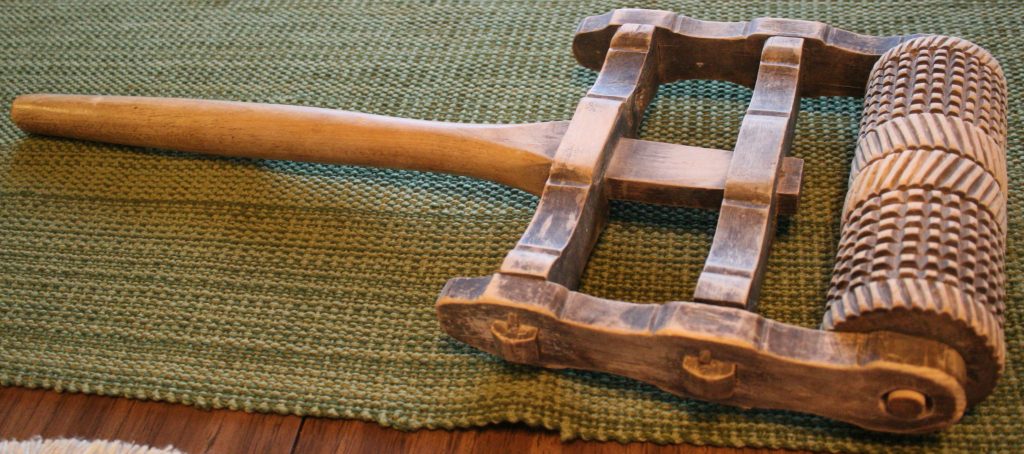
The importance of a personal connection for valuation of handmade items
What is it that makes something particularly precious to you? Although there may be many answers, Giants of the Earth Heritage Center realizes that some people value things that have a particular story behind them. Giants is about preserving real individual connections between people and the way they lived. Because we treasure the uniqueness of each of our ancestors, we take a personalized approach to preservation, and we are opposed to overgeneralizations that caricature our ancestors.
The photo above shows a very old lefse roller handmade by my distant grandfather on a farm in Nesbyen, Norway. There may be many like it in Norway and in the US, but unlike those, this one is particularly valuable to those of us who are descendants of the individual in Hallingdal who carved it. This is the actual one made and used by our ancestors. There are many heirlooms, like this lefse roller, which sit in people’s attics or sheds until the stories associated with them are lost. These heirlooms are then either thrown away or sold for almost nothing to an antique shop, which then sells them to someone who has no idea of their connections to real people. Giants’ online collaborative Spring Grove Area family tree is the perfect way to document your important items and to preserve the stories associated with them. This not only helps these items to find their way to those who would most appreciate them, but also it digitally preserves both the things and the human experiences associated with them, for the enrichment of your whole family and our community.
Reflecting on Pioneer Tools
Some people might ask what we can you learn from the old tools and handiwork of our ancestors? Many would note that they are too busy to learn about such things. Americans try to fill up every unforgiving minute with sixty seconds worth of distance run, or at least sixty seconds worth of busy-work. Yet, it seems the more we try to keep up with the Joneses, the less satisfied we are with ourselves.
When I go through my family’s chests, sheds, and attics, I am always amazed with their ingenuity. So many of them even had their own blacksmith and woodshop, where they handmade every conceivable tool or toy that they or their family found a need to make, and frequently the inventions seem to be totally original.
As scientists learn more and more about human development, they have discovered that many human capacities never develop unless they are needed and cultivated through use. This is because our genome does not just automatically turn the 29,000 genetic recipes it contains into the proteins we need to be be healthy. Rather, only those proteins are produced that our cells sense they need to produce as a result of signals from our environment.
Thus, the activities we do each day determine which of the 29,000 genes we all have are eventually made into the proteins that make up who we are. Over millions of years of hominid and pre-hominid evolution, the gene promoters in front of each gene have evolved in an environment requiring substantial physical and mental effort. Today, our environment has changed significantly, placing our genome signals out of their element and jeopardizing our proper development.
Just as our body requires use in order to grow and be healthy, so too does our mind. Our relatively recent ancestors’ daily activities helped provide the stimulation to produce a healthy mental state, and also provided them with conceptual metaphors for individual, familial, and communal stewardship. Let us consider woodcarving as an activity. Many of our ancestors’ wood tools were carved with a unique respect for the grain of the particular piece of wood. Wood pieces with unique grain variations were set aside because they could make special tools. The carved piece emerged only by cutting out that which didn’t belong.
Preserve by cutting away that which does not need to be there
If you have a truly unique handmade piece of equipment that demonstrates the creativity of your ancestors, please take a digital picture of it and write up what you know about it. We are interested in how our Spring Grove ancestors used their own creative spirit to create what they needed, or to modify what already existed to better suit their needs. These items are particularly of interest if they were not an obvious imitation of an existing design and, further, if they had utility. For example: tools with unique form or function; one-of-a-kind metalwork; or other original inventions are special because they show original thought. Inventions are the product of authentic intentionality coupled with a creative imagination. What is interesting about this? The fact that our ancestors took a lemon and made lemonade is something to be proud of. The fact that some of them put pink flamingos, or their Norwegian equivalents, in their yards is, well…”special.”
Giants supports spring cleaning
Fortunately, Giants is offering you the opportunity to increase the value of your existing heirlooms by linking them to those who owned them. This will help community members to identify hitherto forgotten and underappreciated family heirlooms, and document their stories. Further, if they choose, they can sell them to make space in their home for living life (because sometimes the space is more valuable than anything you could put into it). Want to learn how? Checkout Giants of the Earth’s eBay Giving Works.

With your support, we can provide cutting edge digital preservation of your handmade inventions, images and stories to honor the pioneer craftsmen with whom they were associated. Therefore, we hope our residents will begin publicly documenting those artifacts so that we do not lose track of those interesting connections these artifacts have had with our ancestors. Again, poetic pioneer craftsmanship can be contrasted with contemporary cookie-cutter crafts. Though both activities may produce similar items, the pioneer worked with the mediums of his or her age to produce an authentically functional item that enabled his or her family to move up the Maslowian heierarchy of needs. In contrast, the mere-crafter seeks escape from the mediums of their age by returning to those of the past. The crafters produce kitsch that makes them feel that they have moved up the Maslowian scale. Yet their art is not poetic art, but an imitative work of their hands into which they infuse sentimentality. They wear their “heart upon [their] sleeve, for doves to peck at. (Othello, Act 1, scene 1, 64-65)” Kitschmakers expect others to adore their creations, believing that fawning over these imitations somehow demonstrates a committement to ones heritage. But to what shall we compare this generation of crafters?
“It is like children sitting in the market places, who call out to the other children, and say, ‘We played the flute for you, and you did not dance; we sang a dirge, and you did not mourn.'” Matt 11:16-17

Thus, although imitative handmade crafting can be legitimately performed by apprentices as a means to learn valuable skills and to demonstrate acquisition of such skills, they are now generally done for amusement and conformist-posturing. Because imitations are not authentic creations, and are generally impractical, they mark a turning toward a consumptive rather than a creative lifestyle. Secondly, imitative crafts, created to satisfy a demand for kitschie klatter rather than for needed tools, denote a dogmatic rather than a critical spirit. The dogmatic crafter seeks to replicate in form what their ancestors did. The critical artist asks, “How can I replicate the creative spirit of my ancestors in today’s world?” This is not to say that there should not be a place for traditionalism and consumptive activities. They are excellent ways to build friendships and bonds, learn skills you can later apply to poetic creations, and create something in the process. But we just want to remember that communities like ancient Athens, ancient Rome, and contemporary Spring Grove were not built through consumptively artsy activity in old mediums alone, but by their poetically productive activity. In the case of Greece and Rome some have argued, it was overindulgence in extravagant consumptive activity that invited the barbarians to the gates.
We hope that you will be able to find resources on our website that will help you and your family reconnect with your inner creative capacity and to use that capacity to discover and cultivate your amazing and uniquely human abilities.

Suggested readings
Gibbon, The Decline and Fall of the Roman Empire
Heidegger, The Origin of the Work of Art


